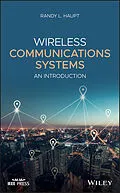A comprehensive introduction to the fundamentals of design and applications of wireless communications
Wireless Communications Systems starts by explaining the fundamentals needed to understand, design, and deploy wireless communications systems. The author, a noted expert on the topic, explores the basic concepts of signals, modulation, antennas, and propagation with a MATLAB emphasis. The book emphasizes practical applications and concepts needed by wireless engineers.
The author introduces applications of wireless communications and includes information on satellite communications, radio frequency identification, and offers an overview with practical insights into the topic of multiple input multiple output (MIMO). The book also explains the security and health effects of wireless systems concerns on users and designers. Designed as a practical resource, the text contains a range of examples and pictures that illustrate many different aspects of wireless technology. The book relies on MATLAB for most of the computations and graphics. This important text:
* Reviews the basic information needed to understand and design wireless communications systems
* Covers topics such as MIMO systems, adaptive antennas, direction finding, wireless security, internet of things (IoT), radio frequency identification (RFID), and software defined radio (SDR)
* Provides examples with a MATLAB emphasis to aid comprehension
* Includes an online solutions manual and video lectures on selected topics
Written for students of engineering and physics and practicing engineers and scientists, Wireless Communications Systems covers the fundamentals of wireless engineering in a clear and concise manner and contains many illustrative examples.
Autorentext
RANDY L. HAUPT, PHD, is a Professor of Electrical Engineering at the Colorado School of Mines and consults for industry and government. He retired from the USAF as a LtCol and was an RF staff consultant at Ball Aerospace & Technologies, Corp.
Inhalt
Preface xiii
Symbols and Acronyms xv
1 Introduction 1
1.1 Historical Development of Wireless Communications 1
1.2 Information 4
1.3 Wired Communications 7
1.4 Spectrum 9
1.5 Communication System 12
Problems 13
References 15
2 Signals and Bits 17
2.1 Analog Baseband Signals 17
2.2 Digital Baseband Signals 21
2.3 Source Coding 22
2.4 Line Coding 26
2.5 Bandwidth 27
2.6 Signal Level 28
2.7 Noise and Interference 29
2.8 Converting Analog to Digital 36
2.9 Channel Coding 39
2.10 Repetition 40
2.11 Parity Bits 40
2.12 Redundancy Checking 42
2.13 Error Correcting Codes (ECC) 45
2.13.1 Block Codes 45
2.13.2 Convolutional Codes 47
2.14 Interleaving 48
2.15 Eye Diagram 50
2.16 Intersymbol Interference 51
2.17 Raised-Cosine Filter 54
2.18 Equalization 57
Problems 62
References 67
3 Passband Signals 71
3.1 Carrier 71
3.2 Amplitude-Modulated Signals 72
3.3 Frequency-Modulated Signals 80
3.4 Phase-Modulated Signals 84
3.5 Quadrature Amplitude Modulation 90
3.6 Power Spectral Density of Digital Signals 92
3.7 BER of Digital Signals 94
3.8 Multiplexing in Time and Frequency 94
3.8.1 Frequency Division Multiplexing 95
3.8.2 Time Division Multiplexing 96
3.8.3 Multiple Access 97
3.9 Spread Spectrum 100
3.9.1 Interference 101
3.9.2 Frequency-Hopping Spread Spectrum 101
3.9.3 Direct-Sequence Spread Spectrum 103
3.9.4 Code Division Multiple Access (CDMA) 104
Problems 106
References 109
4 Antennas 111
4.1 Signal Properties that Influence Antenna Design 111
4.1.1 Impedance 111
4.1.2 Gain 112
4.1.3 Polarization 113
4.1.4 Bandwidth 115
4.2 Common Antennas 116
4.2.1 Point Sources 116
4.2.2 Wire Antennas 117
4.2.3 Aperture Antennas 125
4.2.4 Microstrip Antennas 128
4.3 Antenna Arrays 130
4.3.1 Element Placement 131
4.3.1.1 Linear Array 131
4.3.1.2 Arbitrary Array Layouts 134
4.4 Electronic Beam Steering 136
4.5 Element Pattern 137
4.6 Low Sidelobes 138
4.7 Moving a Null to Reject Interference 140
4.8 Null Filling 142
4.9 Multiple Beams 144
4.10 Antennas for Wireless Applications 146
4.10.1 Handset Antennas 146
4.10.2 Cellular Base Station Antennas 151
4.10.3 Reflector Antennas 156
4.10.4 Antennas for Microwave Links 159
4.11 Diversity 162
4.11.1 Spatial Diversity 162
4.11.2 Frequency Diversity 165
4.11.3 Polarization Diversity 165
4.11.4 Time Diversity 166
Problems 166
References 170
5 Propagation in the Channel 173
5.1 Free Space Propagation 174
5.2 Reflection and Refraction 175
5.3 Multipath 179
5.4 Antennas over the Earth 181
5.5 Earth Surface 186
5.6 Diffraction 190
5.6.1 Fresnel Diffraction 190
5.6.2 Diffraction from Multiple Obstacles 194
5.6.3 Geometrical Theory of Diffraction 198
5.7 Signal Fading 202
5.7.1 Small-Scale Fading Models 205
5.7.1.1 Rayleigh Fading 205
5.7.1.2 Rician Fading 209
5.7.2 Approximate Channel Models 212
5.7.3 Large-Scale Fading 214
5.7.4 Channel Ray-Tracing Models 217
5.8 Doppler Effects 219
<...